
December 31, 2008
Our Travels in 2007 & 2008
Just to give you a better idea of where we've been so far, here's a map showing our travels in red for 2007 and green for 2008....


December 2, 2008
Bosque Del Apache
Bosque del Apache is Spanish for "woods of the Apache," and is rooted in the time when the Spanish observed Apaches routinely camped in the riverside forest. Since then the name has come to mean one of the most spectacular wildlife in North America. Here, tens of thousands of birds--including sandhill cranes, snow geese, and many kinds of ducks--gather each autumn and stay through the winter. At dusk, Kim and I witnessed flight after flight of geese and cranes return to roost in the shallow marsh lakes that line the entry road.
 This is THE hotspot for birding and wildlife photographers this time of year, and this evening was no exception. The largest organized group was led by Larry Ditto from Texas. Larry offers many trips per year, at an affordable price. No question about it, his group was armed with the proper "shooting gear", almost everyone sporting a pro-series camera body, and a 500-plus mm lens! htttp://www.larryditto.com/workshops.htm
This is THE hotspot for birding and wildlife photographers this time of year, and this evening was no exception. The largest organized group was led by Larry Ditto from Texas. Larry offers many trips per year, at an affordable price. No question about it, his group was armed with the proper "shooting gear", almost everyone sporting a pro-series camera body, and a 500-plus mm lens! htttp://www.larryditto.com/workshops.htm
 Although not as well equipped, here are a few of the better images Kim and I were able to capture with our conventional point & shoot rigs.
Although not as well equipped, here are a few of the better images Kim and I were able to capture with our conventional point & shoot rigs.
Most prevalent for this time of year were the snow geese which domintaed the lakes early afternoon. Although by carefully glassing through the masses, we were able to see an occaisional Ross. When seen side by side, their smaller size and unique beak make them easy to spot.
 Late afternoon meant movement for the birds, as we watched pair after pair of these beautiful geese take to the air, headed for other locations in the marsh.
Late afternoon meant movement for the birds, as we watched pair after pair of these beautiful geese take to the air, headed for other locations in the marsh.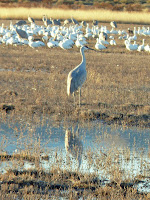 As they left, small groups of Sandhill Cranes began to appear in the distance, headed over to replace the Snows as they left.
As they left, small groups of Sandhill Cranes began to appear in the distance, headed over to replace the Snows as they left.

 With the last red glow of the setting sun almost gone, the view of the winged flight above was replaced by the close proximity of the Moon, Venus & Jupiter.
With the last red glow of the setting sun almost gone, the view of the winged flight above was replaced by the close proximity of the Moon, Venus & Jupiter.
 This is THE hotspot for birding and wildlife photographers this time of year, and this evening was no exception. The largest organized group was led by Larry Ditto from Texas. Larry offers many trips per year, at an affordable price. No question about it, his group was armed with the proper "shooting gear", almost everyone sporting a pro-series camera body, and a 500-plus mm lens! htttp://www.larryditto.com/workshops.htm
This is THE hotspot for birding and wildlife photographers this time of year, and this evening was no exception. The largest organized group was led by Larry Ditto from Texas. Larry offers many trips per year, at an affordable price. No question about it, his group was armed with the proper "shooting gear", almost everyone sporting a pro-series camera body, and a 500-plus mm lens! htttp://www.larryditto.com/workshops.htm Although not as well equipped, here are a few of the better images Kim and I were able to capture with our conventional point & shoot rigs.
Although not as well equipped, here are a few of the better images Kim and I were able to capture with our conventional point & shoot rigs.Most prevalent for this time of year were the snow geese which domintaed the lakes early afternoon. Although by carefully glassing through the masses, we were able to see an occaisional Ross. When seen side by side, their smaller size and unique beak make them easy to spot.

 Late afternoon meant movement for the birds, as we watched pair after pair of these beautiful geese take to the air, headed for other locations in the marsh.
Late afternoon meant movement for the birds, as we watched pair after pair of these beautiful geese take to the air, headed for other locations in the marsh. As they left, small groups of Sandhill Cranes began to appear in the distance, headed over to replace the Snows as they left.
As they left, small groups of Sandhill Cranes began to appear in the distance, headed over to replace the Snows as they left. We have now seen the Sandhill all over the country, as far south as Mississippi. But, it's always a treat to watch these tall creatures. In the numbers here, wow, what a spectacle!

As the sun sunk slowly behind the mountains to the west, wisps of stunning color lit the sky before us...



It wasn't long before a fabulous sunset presented the perfect backdrop for the final images of the day!


 With the last red glow of the setting sun almost gone, the view of the winged flight above was replaced by the close proximity of the Moon, Venus & Jupiter.
With the last red glow of the setting sun almost gone, the view of the winged flight above was replaced by the close proximity of the Moon, Venus & Jupiter. The following morning we talked with several volunteers at the visitor's center, and decided that some day we will come back and volunteer for a season. This is truly an awesome place for wildlife & nature lovers!
November 29, 2008
Nature's Diversity - Death Valley
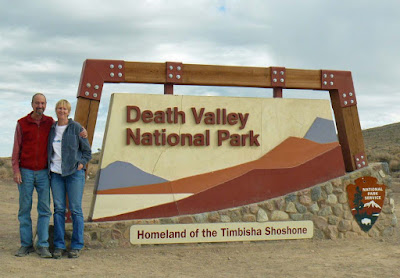 As we continue to roam across North America, Kim & I are constantly amazed at the variety of scenery and terrain that Nature has presented us with. She could have chosen to merely replicate over and over the simple, the mundane, the ordinary. But no – instead She chose to create a wondrous grand presentation of endless beauty over the land. And, within it’s borders, California probably provides the best representation of this diversity, especially within Death Valley National Park.
As we continue to roam across North America, Kim & I are constantly amazed at the variety of scenery and terrain that Nature has presented us with. She could have chosen to merely replicate over and over the simple, the mundane, the ordinary. But no – instead She chose to create a wondrous grand presentation of endless beauty over the land. And, within it’s borders, California probably provides the best representation of this diversity, especially within Death Valley National Park.  Located in a huge trough, between two mountain ranges, the Valley is one of the most unique spots in the country. It is the only watershed that does not carry it’s runoff to any sea. Instead, all the water from the inward sides of the mountains, and everything in between, ends up in the bottom of the vast wilderness. And now the big surprise, not only is there no large beautiful lake at the bottom, instead a desert! But as you’ll see as we continue, there is water here, if you wait long enough and look in some unlikely places…
Located in a huge trough, between two mountain ranges, the Valley is one of the most unique spots in the country. It is the only watershed that does not carry it’s runoff to any sea. Instead, all the water from the inward sides of the mountains, and everything in between, ends up in the bottom of the vast wilderness. And now the big surprise, not only is there no large beautiful lake at the bottom, instead a desert! But as you’ll see as we continue, there is water here, if you wait long enough and look in some unlikely places… As I said this place offered surprises. Kim and I had one of those at our very first stop. Perched high above a small canyon that gave us our first glimpse of the valley, we set up the tripod and cameras. Suddenly we hear a distinct, rapidly approaching whine to our left. Before I could swing the camera around Kim caught this F-16 screaming through the narrow channel below! Then a second follows close behind playing tag within the shear rock walls. What an opening to Death Valley!
As I said this place offered surprises. Kim and I had one of those at our very first stop. Perched high above a small canyon that gave us our first glimpse of the valley, we set up the tripod and cameras. Suddenly we hear a distinct, rapidly approaching whine to our left. Before I could swing the camera around Kim caught this F-16 screaming through the narrow channel below! Then a second follows close behind playing tag within the shear rock walls. What an opening to Death Valley!Reaching the bottom, we realize that we’d always considered New Orleans at eight feet below sea level an anomaly, but now we see that southern California has us beat. We reach the “bottom” and an opening where we can see a small portion of the Valley behind us. Wow, what a dramatic view!

 We had just enough time after setting up the trailer to take a short hike before dark through this enchanted desert beach. The warm red tones of the setting sun against far away mountains clued me that early morning this is where I had to be.
We had just enough time after setting up the trailer to take a short hike before dark through this enchanted desert beach. The warm red tones of the setting sun against far away mountains clued me that early morning this is where I had to be.
 But, growing storm clouds in the distance firm our plans for tomorrow’s (Wednesday) turkey dinner. We awakened to the sounds of rain and wind howling through this flat, unprotected camp. Reinforcing our decision to have Thanksgiving a day early was a good choice. So, our “new “ Alpenlite’s full dining table comes into service, we truly feel “at home” in this spacious environment.
But, growing storm clouds in the distance firm our plans for tomorrow’s (Wednesday) turkey dinner. We awakened to the sounds of rain and wind howling through this flat, unprotected camp. Reinforcing our decision to have Thanksgiving a day early was a good choice. So, our “new “ Alpenlite’s full dining table comes into service, we truly feel “at home” in this spacious environment. While walking out to the Dunes Thursday morning, the rising sun highlights the scorched, cracked earth in the washes below my feet, moments later those first golden rays hit a massive sprawling dune before me, what a sight!
While walking out to the Dunes Thursday morning, the rising sun highlights the scorched, cracked earth in the washes below my feet, moments later those first golden rays hit a massive sprawling dune before me, what a sight!After numerous images, the morning light begins to age into the day, creating those nice long shadows that depict just how dynamic this landscape truly is. And all this beautiful art produced by simple grains of sand blown by Nature’s breath….
Later that morning, we head north, up the Valley to see more of this diverse landscape.
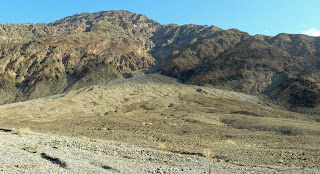 Along the way are numerous examples of the huge “fans” (sprawling flows of loose soil & rock that has been washed down from the mountains over countless years) along the trail, broken by varied examples of colors and textures throughout the route.
Along the way are numerous examples of the huge “fans” (sprawling flows of loose soil & rock that has been washed down from the mountains over countless years) along the trail, broken by varied examples of colors and textures throughout the route.After some fifty miles, we find Ubhebe Crater (yes, that’s You-Be-He-Be, Ha! Ha!) one of the few remaining examples of past volcanic eruptions that once dotted this land.
A few miles to the east we drive upward, through a narrow canyon that increasingly turns green…that’s right, green in this desert! It’s one of the few places that has an abundance of water, the Lower Vine Canyon, where we seek to find Scotty’s Castle. Built in the late 1920's by Albert Johnson, this unfitting landmark sticks out like a sore thumb.

So, what’s it doing out here? Well, I’ll let you do a little research on the many interesting tales of how this all came to be. Try these links:
http://www.desertusa.com/mag98/june/papr/du_dvscotty.html
http://en.wikipedia.org/wiki/Scotty
As we approach the front of the Castle, clear evidence of an unfinished project is presented in the unfinished swimming pool, which at first we thought was a moat!
 Our original intent was to just spend an hour or so here, but the place begged for a closer look, so we signed up for both the inside & basement tours. The inside tour started in this large courtyard, a splendid initial example of the detail in construction we’d be seeing throughout the home.
Our original intent was to just spend an hour or so here, but the place begged for a closer look, so we signed up for both the inside & basement tours. The inside tour started in this large courtyard, a splendid initial example of the detail in construction we’d be seeing throughout the home. 
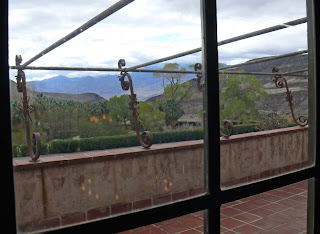
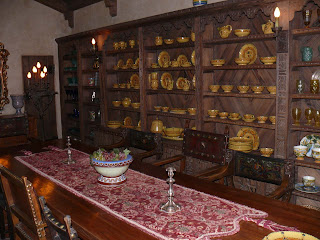
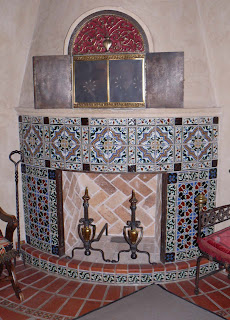

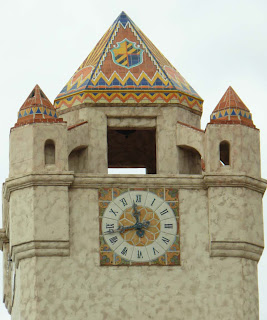 I couldn’t help but notice the many contrast presented in the dwelling, including these beautiful examples of timepieces above the square.
I couldn’t help but notice the many contrast presented in the dwelling, including these beautiful examples of timepieces above the square.The living room (better explained as a hotel lobby!) was the start of the tour, which rambled through just about every room of the house. Exquisite detail was around every corner, with examples of grandeur equally scattered throughout.
Speaking of grandeur, how about having a full pipe organ installed in its own “music room”, complete with a magnificent console. Ironically, neither Johnson nor his wife played, so, a “player roll” was incorporated into the organ, very unique! We were treated to a sampling of “Deck the Halls” by our well-educated tourguide, as he explained that if there were a part for the piano, it would be playing also!


The exit under this magnificent spiral staircase brought us into the water garden area…yes planty of fresh water here, provided by numerous springs on the upper reaches of the property.
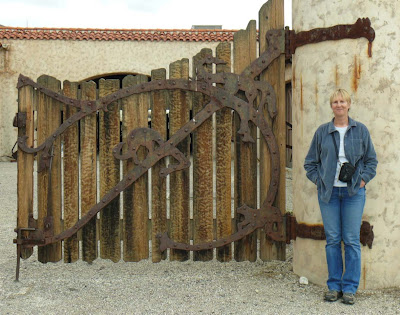 The detail seen inside was carried into the outdoors, as seen here in the fine example of craftsmanship represented in the stable doors.
The detail seen inside was carried into the outdoors, as seen here in the fine example of craftsmanship represented in the stable doors. A quick lunch and back to the house for the basement tour, which started in the boiler room. Extravagance in the desert, that’s what Johnson had created here….running water, steam-heated dwelling, and let’s not forget – electricity. The entire house was powered by a Pelton waterwheel driving a DC generator…..the Pelton deriving it’s power from a 285 foot “head” of water pressure piped down from the springs above.
A quick lunch and back to the house for the basement tour, which started in the boiler room. Extravagance in the desert, that’s what Johnson had created here….running water, steam-heated dwelling, and let’s not forget – electricity. The entire house was powered by a Pelton waterwheel driving a DC generator…..the Pelton deriving it’s power from a 285 foot “head” of water pressure piped down from the springs above.The entire home is surrounded by roughly a mile of “underground” tunnels (which were actually excavated from ground level & poured in concrete to form the outer foundations of the house). While wondering through these basement halls, one couldn’t help but notice row after row of tiles along their walls. Yes, custom handmade tiles that were eventually to be the lining of the huge swimming pool that graced the front entry.
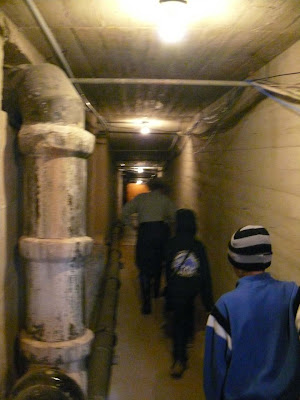

As we walked up the hill back to the truck, I glanced back for one final look at this desert hacienda, just another example of the diversity here at Death Valley.
A couple of other nice formations greeted us one our return to camp. It’s amazing how much one misses if you only drive a road in one direction.
It’s late afternoon as we get a glimpse of the Wells,
 so we decide to take a quick hike at Mosaic Canyon, which is directly south of the Campground.
so we decide to take a quick hike at Mosaic Canyon, which is directly south of the Campground.

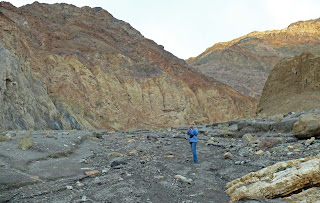
Mosaic starts with as fine example of a rather wide “slot” canyon, but soon opens up into an expansive wash, surrounded by walls of geological history.
As sunset approaches, we find the colors are enhanced through the maze of slots heading out, and are finally treated to this spectacular view of the Wells Campground as we exit…

 Our final day starts with a visit to the old Harmony Borax Works, remnants of bygone days, when Twenty Mule Team was a household word. Shadows of the past lurk across crumbling adobe walls, telling a story of the days of fortune here in the Valley. While most cam to seek gold, those who hit the big bonanza actually found it in what appeared to be a worthless white powder.
Our final day starts with a visit to the old Harmony Borax Works, remnants of bygone days, when Twenty Mule Team was a household word. Shadows of the past lurk across crumbling adobe walls, telling a story of the days of fortune here in the Valley. While most cam to seek gold, those who hit the big bonanza actually found it in what appeared to be a worthless white powder.
The diversity continues as we drive out through “Golden Canyon” …. showing it’s sulfur coloring along the walls, and evidence of Wednesday’s rain along the floor.

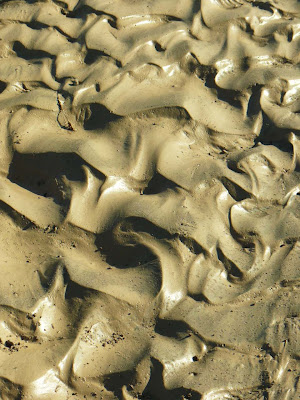
So now on to what most associate with Death Valley, the vast salt beds at the lower (southern) end of the Valley. First stop is at the “Devil’s Golfcourse”, which sounds a bit strange until you look out over and try to walk across the ragged, sharp crust formed by mud and salt.

 To even find a golf ball down in this stuff would be a challenge, let alone trying to chip one out of here!
To even find a golf ball down in this stuff would be a challenge, let alone trying to chip one out of here!Oh, and if you should happen to slip and fall, the embedded salt in the cuts will make sure each one burns like fire (of course, I slipped!).
Another couple of miles and we reach “Badwater”, where vast flat plains of the white stuff lay stretched before us.
 As I stoop for a closer look, we discover a hole that the kids dug that shows water lurks only inches below the crusty, dry desert surface…yes that’s right BAD WATER!
As I stoop for a closer look, we discover a hole that the kids dug that shows water lurks only inches below the crusty, dry desert surface…yes that’s right BAD WATER!
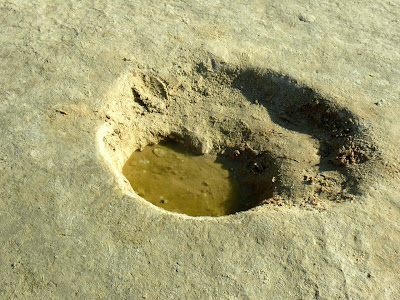
 It’s late afternoon, and our drive back is through the Artist’s Paints loop. Again those afternoon colors greet us as we gaze across a huge fault line on the eastern edge of the Valley.
It’s late afternoon, and our drive back is through the Artist’s Paints loop. Again those afternoon colors greet us as we gaze across a huge fault line on the eastern edge of the Valley. Evidence of perhaps copper or manganese appears around the final bend, as we head back to camp after another great day here at Death Valley!
Subscribe to:
Posts (Atom)













